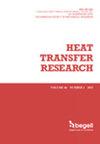FC-72 小管中的流动沸腾临界热通量
IF 1.6
4区 工程技术
Q3 THERMODYNAMICS
引用次数: 0
摘要
实验研究了 FC-72 在小管内的流动沸腾。管子材料为 SUS304 不锈钢,内径为 1.8 毫米,长度为 129 毫米。实验测量了流速和过冷度对临界热通量(CHF)的影响。流速 u 在 0.33 至 4.26 m/s 之间变化,入口过冷度在 25 至 36 K 之间变化。实验结果表明,CHF 随流速的增加而增加,但在 u = 3.0 m/s 以上,由于过早出现 CHF,CHF 急剧下降。在实验数据的基础上,得到了沸腾数和韦伯数之间的经验相关性。该相关性的预测值与测量数据的一致性在 17% 以内。本文章由计算机程序翻译,如有差异,请以英文原文为准。
Flow boiling critical heat flux in a small tube for FC-72
Flow boiling of FC-72 in a small tube was investigated experimentally. The material of the tube was SUS304 stainless steel with an inner diameter of 1.8 mm and a length of 129 mm. The effect of flow velocity and subcooling on critical heat flux (CHF) was measured in this experiment. The flow velocity, u, was varied from 0.33 to 4.26 m/s, and the inlet subcooling degree was varied from 25 to 36 K. The heat transfer coefficients from the non-boiling to boiling region were then measured. Experimental results showed that CHF increased as flow velocity was raised, but it sharply declined above u = 3.0 m/s because of premature CHF. On the basis of the experimental data, the empirical correlation between the boiling number and Weber number was obtained. The predicted value of this correlation was in agreement with the measured data within 17%.
求助全文
通过发布文献求助,成功后即可免费获取论文全文。
去求助
来源期刊

Heat Transfer Research
工程技术-热力学
CiteScore
3.10
自引率
23.50%
发文量
102
审稿时长
13.2 months
期刊介绍:
Heat Transfer Research (ISSN1064-2285) presents archived theoretical, applied, and experimental papers selected globally. Selected papers from technical conference proceedings and academic laboratory reports are also published. Papers are selected and reviewed by a group of expert associate editors, guided by a distinguished advisory board, and represent the best of current work in the field. Heat Transfer Research is published under an exclusive license to Begell House, Inc., in full compliance with the International Copyright Convention. Subjects covered in Heat Transfer Research encompass the entire field of heat transfer and relevant areas of fluid dynamics, including conduction, convection and radiation, phase change phenomena including boiling and solidification, heat exchanger design and testing, heat transfer in nuclear reactors, mass transfer, geothermal heat recovery, multi-scale heat transfer, heat and mass transfer in alternative energy systems, and thermophysical properties of materials.
 求助内容:
求助内容: 应助结果提醒方式:
应助结果提醒方式:


